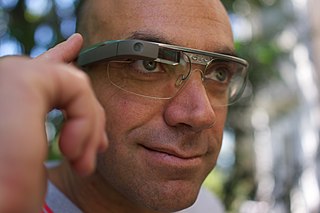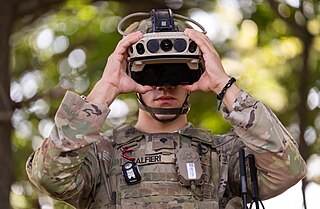
Augmented reality (AR) is an interactive experience that combines the real world and computer-generated content. The content can span multiple sensory modalities, including visual, auditory, haptic, somatosensory and olfactory. AR can be defined as a system that incorporates three basic features: a combination of real and virtual worlds, real-time interaction, and accurate 3D registration of virtual and real objects. The overlaid sensory information can be constructive, or destructive. This experience is seamlessly interwoven with the physical world such that it is perceived as an immersive aspect of the real environment. In this way, augmented reality alters one's ongoing perception of a real-world environment, whereas virtual reality completely replaces the user's real-world environment with a simulated one.

Mixed reality (MR) is a term used to describe the merging of a real-world environment and a computer-generated one. Physical and virtual objects may co-exist in mixed reality environments and interact in real time.

A head-mounted display (HMD) is a display device, worn on the head or as part of a helmet, that has a small display optic in front of one or each eye. An HMD has many uses including gaming, aviation, engineering, and medicine. Virtual reality headsets are HMDs combined with IMUs. There is also an optical head-mounted display (OHMD), which is a wearable display that can reflect projected images and allows a user to see through it.

Oculus Rift is a discontinued line of virtual reality headsets developed and manufactured by Oculus VR, a virtual reality company founded by Palmer Luckey that is widely credited with reviving the virtual reality industry. It was the first virtual reality headset to provide a realistic experience at an accessible price, utilizing novel technology to increase quality and reduce cost by orders of magnitude compared to earlier systems. The first headset in the line was the Oculus Rift DK1, released on March 28, 2013. The last was the Oculus Rift S, discontinued in April of 2021.

An optical head-mounted display (OHMD) is a wearable device that has the capability of reflecting projected images as well as allowing the user to see through it. In some cases, this may qualify as augmented reality (AR) technology. OHMD technology has existed since 1997 in various forms, but despite a number of attempts from industry, has yet to have had major commercial success.

Magic Leap, Inc. is an American technology company that released a head-mounted augmented reality display, called Magic Leap One, which superimposes 3D computer-generated imagery over real world objects. It is attempting to construct a light-field chip using silicon photonics.

Meta was a company that designed augmented reality products. The company was founded by Meron Gribetz in 2012, based on the "Extramissive spatial imaging digital eye glass" technology invented by Gribetz and Mann originally filed with the US Patent and Trademark office Jan 3, 2013.

Windows Mixed Reality is a platform introduced as part of the Windows 10 and 11 operating system, which provides augmented reality and virtual reality experiences with compatible head-mounted displays.

Microsoft HoloLens is an augmented reality (AR)/mixed reality (MR) headset developed and manufactured by Microsoft. HoloLens runs the Windows Mixed Reality platform under the Windows 10 operating system. Some of the positional tracking technology used in HoloLens can trace its lineage to the Microsoft Kinect, an accessory for Microsoft's Xbox 360 and Xbox One game consoles that was introduced in 2010.

AltspaceVR was a social VR platform that was founded in 2013 by Eric Romo and launched its initial product in May 2015. In 2017 it was acquired by Microsoft and became part of the Mixed Reality division within the Cloud and AI group. Some elements of the platform appear in Microsoft Mesh.
A vision processing unit (VPU) is an emerging class of microprocessor; it is a specific type of AI accelerator, designed to accelerate machine vision tasks.
OpenXR is an open-source, royalty-free standard for access to virtual reality and augmented reality platforms and devices. It is developed by a working group managed by the Khronos Group consortium. OpenXR was announced by the Khronos Group on February 27, 2017, during GDC 2017. A provisional version of the standard was released on March 18, 2019, to enable developers and implementers to provide feedback on it. On July 29, 2019, OpenXR 1.0 was released to the public by Khronos Group at SIGGRAPH 2019.
The Azure Kinect DK is a developer kit and PC peripheral which employs the use of artificial intelligence sensors for computer vision and speech models, and is connected to the Microsoft Azure cloud. It is the successor to the Microsoft Kinect line of sensors.

Alex Kipman is a Brazilian engineer. He was the lead developer of the Microsoft HoloLens smartglasses and helped develop the Xbox Kinect.

The Integrated Visual Augmentation System (IVAS) is an augmented reality headset being developed by Microsoft for the United States Army, providing a wide variety of new capabilities to soldiers. Originally developed for infantry, it is also being adapted for use by mounted soldiers and aircrew. Its development was initiated in 2018 and is currently undergoing testing, although numerous problems have repeatedly delayed its deployment in the field.
Microsoft Holoportation is a project from Microsoft Research that demonstrates real-time holographic communications with the Microsoft Hololens. Holoportation is described as "a new type of 3D capture technology that allows high-quality 3D models of people to be reconstructed, compressed and transmitted anywhere in the world in real time. This allows users wearing virtual or augmented reality displays to see, hear and interact with remote participants in 3D, almost as if they were present in the same physical space. From an audio-visual perspective, communicating and interacting with remote users edges closer to face-to-face communication." The project was launched by Shahram Izadi and his Microsoft team in 2016. In March 2016, Alex Kipman performed a live demonstration of the technology at the TED conference as part of his talk. In 2020, Microsoft Mesh was launched which offered Holoportation capabilities to "project yourself as your most lifelike, photorealistic self in mixed reality to interact as if you are there in person"

Vergence-accommodation conflict (VAC), also known as accommodation-vergence conflict, is a visual phenomenon that occurs when the brain receives mismatching cues between vergence and accommodation of the eye. This commonly occurs in virtual reality devices, augmented reality devices, 3D movies, and other types of stereoscopic displays and autostereoscopic displays. The effect can be unpleasant and cause eye strain.
The Meta Quest Pro is a mixed reality (MR) headset developed by Reality Labs, a division of Meta Platforms.

Mixed Reality Toolkit (MRTK) is an open-source software development kit (SDK) developed by Microsoft in 2016 for the development of mixed reality (MR) and augmented reality (AR) software applications. It consists of a collection of components and features designed to enhance the mixed reality user and developer experiences. The toolkit was originally developed by Microsoft for the release of the HoloLens 1 augmented reality headset, although it supports a variety of platforms.














